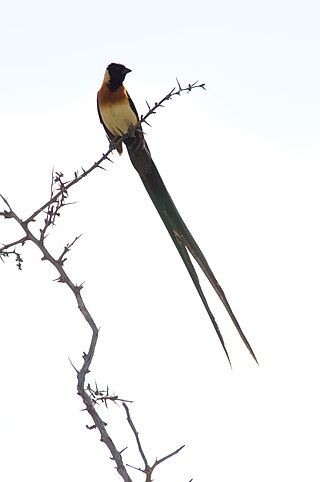
The indigobirds and whydahs, together with the cuckoo-finch, make up the family Viduidae; they are small passerine birds native to Africa.

Estrildidae, or estrildid finches, is a family of small seed-eating passerine birds of the Old World tropics and Australasia. They comprise species commonly known as munias, mannikins, firefinches, parrotfinches and waxbills. Despite the word "finch" being included in the common names of some species, they are not closely related to birds with this name in other families, such as the Fringillidae, Emberizidae or Passerellidae.

The Australian zebra finch is the most common estrildid finch of Central Australia. It ranges over most of the continent, avoiding only the cool humid south and some areas of the tropical far north. The bird has been introduced to Puerto Rico and Portugal. Due to the ease of keeping and breeding the zebra finch in captivity, it has become Australia’s most widely studied bird; by 2010, it was the most studied captive model passerine species worldwide, by a considerable margin.

Brood parasitism is a subclass of parasitism and phenomenon and behavioural pattern of certain animals, brood parasites, that rely on others to raise their young. The strategy appears among birds, insects and fish. The brood parasite manipulates a host, either of the same or of another species, to raise its young as if it were its own, usually using egg mimicry, with eggs that resemble the host's.

The village indigobird, also known as the steelblue widowfinch or the Combassou finch, is a small songbird belonging to the family Viduidae. It is distinguishable from other indigobird species by bill and leg colours, the colour tinge of the male's breeding plumage, song, and to lesser extent, the nestling's plumage and mouth pattern. The bill colour can be red or white depending on the population, and there is some regional variation in the colour tone of the male's plumage.

The pin-tailed whydah is a small songbird with a conspicuous pennant-like tail in breeding males. It is a resident breeding bird in most of Africa south of the Sahara Desert.

The shaft-tailed whydah or queen whydah is a small, sparrow-like bird in the genus Vidua. During the breeding season the male has black crown and upper body plumage, golden breast and four elongated black tail shaft feathers with expanded tips. After the breeding season is over, the male sheds its long tail and grows olive brown female-like plumage.

The rock firefinch is a species of estrildid finch found in the Jos Plateau of central Nigeria and in Cameroon. It has an estimated global extent of occurrence of 29,000 km2. The rock firefinch was discovered recently, in 1998. Rock firefinches fall in the family Estrildidae, which contains small passerine birds of the Old World and Australasia. Rock firefinches seem to be most closely related to Mali firefinches and Chad firefinches. The species name sanguinodorsalis means blood-red back, which was chosen because it describes the vibrant red back color of the male plumage. The status of the species is evaluated as Least Concern.

The cuckoo-finch, also known as the parasitic weaver or cuckoo weaver, is a small passerine bird now placed in the family Viduidae with the indigobirds and whydahs. It occurs in grassland in Africa south of the Sahara. The male is mainly yellow and green while the female is buff with dark streaks. They lay their eggs in the nests of other birds.

The exclamatory paradise whydah or Uelle paradise whydah is a species of bird in the family Viduidae. It is also known as the long-tailed paradise whydah, a name which may also refer to the related species Vidua paradisaea.
The barka indigobird is a species of bird in the family Viduidae. It is found in Cameroon, Ethiopia, Gambia, Ghana, Guinea, Nigeria, Sudan, and South Sudan. It is also known as the baka indigobird but the spelling "barka" is more correct; the word is a greeting in the Hausa language.

The broad-tailed paradise whydah is a species of bird in the family Viduidae. It is found woodland and acacia savanna habitat in Sub-Saharan Africa from Angola to Uganda, Tanzania and Mozambique. A brood parasite, it has a wide range and the International Union for Conservation of Nature has assessed it as being of least concern.
The Cameroon indigobird is a species of bird in the family Viduidae. It is considered by some authors to be a subspecies of the variable indigobird. They range from Sierra Leone to east Cameroon, north east Zaire and South Sudan.
The quailfinch indigobird is a small songbird. It is a resident breeding bird in The Gambia, Nigeria and Cameroon. It occurs in isolated localities, especially on river flood plains.

The Sahel paradise whydah, yellow-naped whydah or northern paradise whydah is a small songbird.
Five species of indigobird are known as paradise whydah:

















